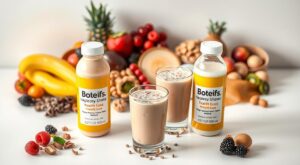Imagine standing at a crossroads, where your choices today can shape your health and future. Every bite you take can protect your heart, an organ that works for you all your life. As we near 2025, a heart-healthy diet becomes more critical. Heart disease is a major killer in the U.S.
You can make a difference by adding the best heart-healthy foods to your meals. This article will guide you through easy tips and tasty options. It’s your chance to improve your diet and keep your heart strong.
Understanding Heart Health and Nutrition
Keeping your heart healthy is not just about exercise and lifestyle. Nutrition is also key to understanding heart health. Eating a balanced diet with fruits, veggies, whole grains, and lean proteins is essential. These foods give your heart the nutrients it needs to stay healthy.
Foods packed with vitamins, minerals, and antioxidants can help fight heart disease. They can lower blood pressure and cholesterol levels. This is important for your heart’s well-being.
Adding heart-healthy nutrition to your daily life can greatly improve your heart’s function. It’s all about choosing the right foods. For example, foods high in fiber can help lower cholesterol. Healthy fats also play a big role in keeping your heart healthy.
Knowing how your diet affects your heart is powerful. It lets you make choices that help you live longer and feel better.
Benefits of a Heart-Healthy Diet
Choosing a heart-healthy diet brings many benefits. It helps lower blood pressure and improve cholesterol levels. This is great for your heart health.
People who eat this way often feel better. They might lose weight, have more energy, and feel more alive.
Studies show that eating healthy fats and nutrients helps prevent diseases. Foods like avocados, nuts, and fatty fish are good for you. They help keep your heart strong and can even help you live longer.
Eating fruits and vegetables adds more nutrients to your diet. Each bite helps your body and heart stay healthy. Starting these habits now can lead to a happier, healthier future.
Best Foods for Heart Health
Choosing the right foods is key for heart health. A variety of nutrient-rich foods can greatly benefit your heart. Each food group adds something special to your diet, making it heart-friendly.
Leafy Greens and Their Nutritional Impact
Leafy greens like spinach, kale, and collard greens are full of vitamins and minerals. They’re rich in potassium, which helps control blood pressure and keeps your heart healthy. Adding these greens to your meals boosts your nutrition and supports heart health.
Fruits That Support Heart Function
Fruits like berries, oranges, and apples are full of antioxidants. These fight inflammation and support heart function with essential vitamins. Eating a variety of colorful fruits daily can make your diet heart-friendly and delicious.
Whole Grains for Cardiovascular Health
Whole grains like brown rice, quinoa, and barley are important for lowering bad cholesterol. They’re high in fiber, which is good for your digestive system. Make sure half of your grains are whole to support heart health. Learn more about a balanced diet at this resource.
Essential Nutrients for Heart Health
Heart-healthy nutrition focuses on key nutrients. Omega-3 fatty acids and dietary fiber are two important ones. They help keep your heart in good shape, so it’s important to eat them every day.
Omega-3 Fatty Acids and Their Sources
Omega-3 fatty acids fight inflammation and boost heart health. You can find them in:
- Fatty fish like salmon, mackerel, and sardines
- Flaxseeds and chia seeds
- Walnuts and algae-based supplements
Eating these foods can greatly help your heart. It supports your overall health and lowers heart disease risk.
Importance of Fiber in Your Diet
Dietary fiber is also vital for heart health. It helps with digestion and lowers cholesterol. This improves heart function. Good fiber sources are:
- Whole grains like oats, brown rice, and quinoa
- Fruits like apples, berries, and bananas
- Vegetables, including beans, lentils, and broccoli
Adding these fiber-rich foods to your diet helps with heart health. It also supports long-term wellness.

Incorporating Healthy Fats into Your Meals
Understanding the role of healthy fats is key for heart-healthy nutrition. Fats are important in your diet. Choosing the right types can boost your heart health. Healthy fats, like monounsaturated and polyunsaturated, improve cholesterol and give energy.
Sources of these good fats include:
- Olive oil
- Avocados
- Nuts such as almonds, walnuts, and pistachios
To replace unhealthy fats, try these tips:
- Use olive oil instead of butter for cooking.
- Add sliced avocado to salads or sandwiches.
- Snack on a small handful of nuts instead of chips or cookies.
Choosing better foods can greatly improve your heart health. Remember, adding healthy fats to your meals is a simple way to boost your health.
Low-Fat Protein Sources to Consider
Protein is important for your health, but the kind you choose is key. Going for low-fat protein helps your heart and meets your nutritional needs. Adding skinless poultry, fish, and plant-based foods makes your diet balanced.
Benefits of Choosing Lean Meat and Fish
Lean meats and fish are great for your diet. Skinless chicken and turkey give you amino acids without too much fat. Fish like salmon and mackerel are full of omega-3s, which are good for your heart.
Plant-Based Proteins for Heart Health
Plant-based proteins can make your diet even healthier. Legumes like lentils and beans are high in fiber and protein. Tofu and tempeh are low in fat and add variety to your meals. They boost your heart health by reducing fat and adding antioxidants.

The Role of Vegetables and Fruits in Your Daily Diet
Eating a heart-friendly diet means adding lots of vegetables and fruits. These foods are full of vitamins, minerals, and antioxidants. Eating seven to ten servings a day can help lower blood pressure and cholesterol.
Choose a variety of vegetables for more nutrients. Leafy greens like spinach and kale are great. Bright colors like bell peppers and carrots add flavor and nutrients. Fruits like berries, citrus, and apples are also full of fiber and antioxidants.
Always pick seasonal produce for the best taste and nutrition. Store vegetables in a cool, dry place and fruits in the fridge. Wrapping them in paper towels helps keep them fresh longer.
Steaming or sautéing vegetables is better than boiling. It keeps more vitamins. You can also blend fruits into smoothies or add them to oatmeal for a tasty way to get your daily servings.
Adding more vegetables and fruits to your diet is easy. With a few simple tips, you can make them a big part of your meals. This choice is great for your heart’s health over time.
This approach aligns with recommendations found at top anti-inflammatory foods.
Vegetables and fruits are key to a healthy diet. Make them a main part of your meals. Enjoy every bite and take steps towards a healthier heart.
Choosing Whole Grains to Lower Cholesterol
Choosing whole grains is a great way to boost your heart health. Foods like brown rice, quinoa, and whole wheat are full of nutrients. They help your heart work better.
Whole grains are packed with fiber, which is key for controlling cholesterol. Research shows that eating a lot of fiber can lower bad cholesterol. It also helps increase good cholesterol.
When shopping, pick products that say “100% whole grain” or “whole grain” first. Look for brands like Bob’s Red Mill, Quaker, and Nature’s Path. Swapping white rice for brown or adding quinoa to salads can make a big difference.
Try making tasty whole grain dishes like barley soup or oatmeal with fruits and nuts. Being creative with whole grains can make them a regular part of your diet. For more ideas, check out the benefits and types of whole grain.

Limiting Unhealthy Fats: What You Should Know
Your heart health is closely tied to the fats you eat. It’s key to cut down on unhealthy fats like saturated and trans fats. These fats can raise your cholesterol levels, which ups the risk of heart disease.
The American Heart Association has clear rules for cutting down on bad fats. They say to keep saturated fats under 7% of your daily calories. It’s important to read food labels to spot these harmful fats. Look for hydrogenated oils, which usually mean trans fats are present.
Here are some tips for a heart-healthy diet:
- Choose lean meats and skinless poultry.
- Eat fish like salmon and mackerel for omega-3s.
- Use olive or canola oil instead of butter.
- Focus on whole foods like fruits, veggies, and grains, which are low in bad fats.
Knowing how your diet affects your heart lets you make better choices. By cutting down on unhealthy fats, you can boost your heart health and overall health.
The Importance of Portion Control
Understanding portion control is key for heart health. It helps keep your weight in check and supports your heart. By managing how much you eat, you can change your eating habits for the better. This leads to long-term health gains and a more enjoyable eating experience.
Tips for Managing Portion Sizes
- Use smaller plates to create an illusion of a fuller serving.
- Pre-measure snacks to avoid overindulging.
- Fill half your plate with vegetables to promote a balanced meal.
- Listen to your body’s signals for fullness, eating slowly allows you to recognize them.
Mindful Eating Practices
Mindful eating changes how you view meals. Focus on each bite by removing distractions. This helps you appreciate your food more.
Notice the flavors, textures, and smells of your food. This makes eating more enjoyable.
To enhance your experience, try these mindful eating techniques:
- Chew your food thoroughly and savor each bite.
- Pause between bites to assess your hunger levels.
- Avoid eating straight from containers, as it promotes overeating.

Reducing Sodium and Its Impact on Heart Health
Too much sodium can raise blood pressure, leading to heart problems. The American Heart Association suggests eating less than 2,300 milligrams of sodium daily. For better heart health, aim for 1,500 milligrams a day, which is best for those with high blood pressure.
To follow a heart-healthy diet, try not to use salt. Use herbs and spices to add flavor to your food. For instance, basil, oregano, and garlic can make dishes taste great without sodium. Also, citrus juices or vinegar can add a fresh touch.
It’s important to read food labels carefully. Look for “low sodium” or “no added salt” labels. Compare different products to find ones that fit your sodium-reducing goals. Knowing how to read labels helps you make better choices for your heart health.
Planning Your Heart-Healthy Meals
Meal planning is key to a heart-healthy diet. By picking the right ingredients and making a menu, you can add nutritious foods to your day. A good meal plan balances meals from different food groups. This ensures you get all the nutrients you need and keep portion sizes right.
This method not only helps your heart but also boosts your overall health.
Creating a Balanced Daily Menu
Your daily menu should have fruits, veggies, whole grains, lean proteins, and healthy fats. When planning heart-healthy meals, remember these key points:
- Breakfast: Start with oatmeal, berries, and nuts.
- Lunch: Try a quinoa salad with greens, cherry tomatoes, and grilled chicken.
- Dinner: Salmon, steamed broccoli, and brown rice is a great mix.
- Snacks: Choose fresh fruits, yogurt, or almonds for a healthy snack.
Sample Meal Plans for Heart Health
Here’s a sample meal plan for one day to help you plan heart-healthy meals:
| Meal | Food Item | Nutritional Benefits |
|---|---|---|
| Breakfast | Oatmeal with Blueberries | High in fiber and antioxidants |
| Lunch | Spinach Salad with Chickpeas | Rich in vitamins and protein |
| Dinner | Baked Cod with Asparagus | Low in fat and high in omega-3s |
| Snacks | Apple Slices with Almond Butter | Provides healthy fats and fiber |
By following this meal plan and focusing on heart-healthy meals, you can greatly improve your heart health. Plus, you’ll enjoy tasty food too.
Heart-Healthy Snacks for Daily Energy
Adding heart-healthy snacks to your diet can give you the energy you need. Making smart choices helps keep you energized and your heart healthy. There are many quick and easy snack options that are good for you.
Nuts like almonds and walnuts are great for your heart. They are full of healthy fats, fiber, and protein. They help you feel full and can lower your cholesterol.
Low-fat Greek yogurt is another excellent choice. It’s packed with protein and calcium, and it has probiotics for your gut health.
Fresh fruits like apples, bananas, and berries are also good for your heart. They give you important vitamins and antioxidants. Plus, they are low in calories, making them perfect for heart health.
Having a variety of heart-healthy snacks on hand is helpful. Prepare snack packs with your favorite nuts, yogurt, or fruits before time. This way, you’ll always have healthy options to keep your energy up and support your heart health all day.
Tools and Techniques for Heart-Healthy Cooking
Heart-healthy cooking can greatly improve your health. Grilling, steaming, and baking are great methods. They boost flavors and cut down on unhealthy fats. These ways of cooking keep nutrients in and make food more fun to eat.
Having the right tools for heart health makes cooking better. Non-stick pans help avoid extra fats, and measuring cups keep portions right. Good kitchen tools make cooking healthy food easier and more fun.
- Grilling enhances natural flavors and requires minimal oil.
- Steaming retains nutrients and provides a healthy way to cook vegetables.
- Baking offers a lower-fat alternative to frying while keeping dishes moist.
Using heart-healthy cooking techniques and tools helps you eat better. Cooking at home is healthier and more fun. It also lets you get creative in the kitchen.
Conclusion
Embracing heart-healthy eating is key to preventing heart disease and improving overall health. Focus on foods like fruits, vegetables, whole grains, and healthy fats. These choices lead to a healthier lifestyle in 2025 and beyond.
Knowing how food affects your heart helps you make better choices. This knowledge empowers you to pick options that are good for your health.
To eat better, manage your portion sizes and try new foods. These steps boost your heart health and help you develop lasting habits. They improve your life quality.
The path to a healthy heart starts with small changes in your diet. Choose heart-healthy foods and make smart choices. This way, you create a healthy environment for your heart and overall well-being. It sets you up for a brighter, healthier future.













